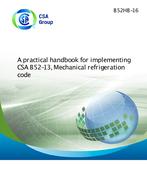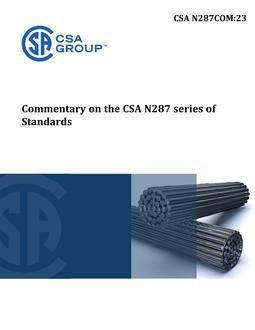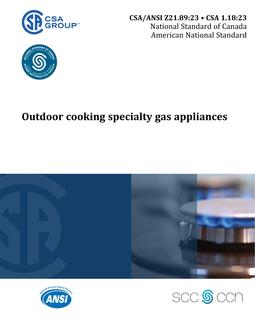
CSA B52HB-16
- Comments Off on CSA B52HB-16
- CSA
Preface
This is the second edition of CSA B52 HB, A practical handbook for implementing CSA B52-13, Mechanical refrigeration code. The primary objective of this handbook is to provide both novice and experienced users of CSA B52 with a concise, user-friendly guide to understanding and implementing the requirements of CSA B52. The B52 Code, which originated in 1939, has been regularly updated throughout the years and is now in its eleventh edition. This handbook also briefly describes the evolution of CSA B52, touching on the Code?s development process, updates and interpretations, and the relationship between the Code and jurisdictional regulations. Changes in the CSA B52-13 Standard are reflected in this edition of the handbook. As society has been advocating the change to natural refrigerants in order to preserve the environment, there are many safety issues which must be addressed. This version of the CSA B52 handbook will provide many of the recommended minimum safety protocols to be adhered to, in order to avoid issues. Many of the changes along with an explanation are as follows: a) Clause 3 has been updated to add the following definitions:
- i) automated control; ii) fade-out vessel; iii) gas cooler; iv) manual control; v) pressure-regulating relief valve; vi) primary refrigerant; vii) secondary refrigerant; viii) subcritical; ix) subcritical system; x) systems; xi) supercritical; xii) thermal relief device (or thermal expansion relief device); xiii) transcritical system; and xiv) triple point;
b) Updates to Clause 4.3.1.2.3: This Clause provides explanations and figures of the various system types with reference to the evaporator containing refrigerant being in contact with the occupied space; c) Updates to Clauses 5.5.1, 5.6, 5.7.1, and 5.8.1 and the addition of Clause 5.9.2.1c): As R-744 carbon dioxide is becoming a major refrigerant within refrigeration and heat pump systems, the CSA B52 committee has gone to extensive measures to provide the most up-to-date minimum safety requirements as can be found within some of these clauses; d) The addition of a note to Clause 6.3 and an update to Clause 6.3d); e) Updates to Clauses 7.2.2.1 and the addition of Clause 7.2.2.4: Further changes attributed to the reintroduction of R-744; f) Updates to Clause 7.2.3 to include
- i) renumbering of Clauses 7.2.3.1.1, 7.2.3.1.2, and 7.2.3.3 of the 2005 edition; and ii) the addition of Clauses 7.2.3.2, 7.2.3.2.1, and 7.2.3.2.2;
g) Updates to Clause 7.2.4: R-744?s physical properties demonstrate that it has pressures higher than standard refrigeration components pressure ratings. The expansion rate of R-744 is nearly double that of standard refrigerants. It is for this reason emphasis must be placed on the avoidance of the trapping of liquid. Many of the changes to the Code will address minimum recommended practices to avoid pressure related concerns; h) Updates to Table 6; i) The addition of Clause 7.3.6.5; j) Updates to Clauses 8.1, 8.2, 8.3, 8.4.1, and 8.4.3 and the addition of Clause 8.4.4: Previous versions of CSA B52 typically did not address in detail preventative maintenance of systems and service practices. It is evident with the advent of higher pressure refrigerants, and in an effort to preserve the environment and reduce energy consumption, preventative maintenance of systems is required to ensure the equipment and its surroundings do not become compromised as a result of poor service and maintenance practices. Poor service and/or maintenance practices can result in a rupture of pressurized components resulting in loss of charge and potential personnel injury and damage to the building environment. Service and maintenance will help avoid system-debilitating causes and concerns such as corrosion, blockages, poor heat transfer, and low operating efficiencies resulting in higher than normal energy consumption and obviously reducing loss of system charge and prolonging equipment lifespan, etc. It is for these reasons that the B52 committee has advocated minimum recommended service and maintenance practices, such as refrigerant charging and withdrawal and evacuation and scheduled routine maintenance as per the equipment manufacturer?s and governmental guidelines. Annexes I, J, K and L have been added for information to provide the user with background knowledge which can assist in the implementation of CSA B52; k) Updates to Annex I: This Annex provides information regarding replacement refrigerants and hydrocarbon refrigerants; l) The addition of Annex J: This addition to the Code highlights some of the concerns when using R-744. Issues such as the effects of moisture and contact with ammonia, along with handling precautions and emphasis of eliminating potential hazards when using R-744; m) The addition of Annex K: This addition provides some of the physical properties of R-744. Although carbon dioxide is designated as a Class A1 refrigerant, as with any refrigerant, it will displace oxygen in higher than normal quantities. As with all refrigerants, precautionary care must be taken to avoid asphyxiation; and n) The addition of Annex L: As new refrigerants are continuously being developed and some of the older refrigerants still found within systems, the B52 committee has decided it would be advantageous to the user to maintain information on some of the more commonly used refrigerants. Also, CSA B52 recommends that the user refer to ASHRAE 34 for the most current information regarding refrigerants.
Scope of CSA B52
The scope of CSA B52 is to provide minimum requirements for the design, construction, installation, inspection and maintenance of all mechanical refrigeration systems, as provided for by provincial and territorial acts, to minimize the risk of human injury. The Code applies to all refrigeration systems installed subsequent to its jurisdictional adoption, whether in new or existing premises, to systems that undergo a substitution of refrigerant, and to parts of a refrigeration system that are replaced in, or added to, refrigeration systems installed prior to its adoption. The word “adoption” refers to the date a jurisdiction adopts the Code, and so not necessarily to the year in which the Code was published.
Product Details
- Edition:
- 2nd
- Published:
- 03/01/2016
- ISBN(s):
- 9781488302084
- Number of Pages:
- 85
- File Size:
- 1 file , 2.7 MB
- Product Code(s):
- 2424136, 2424918, 2424136, 2424136



